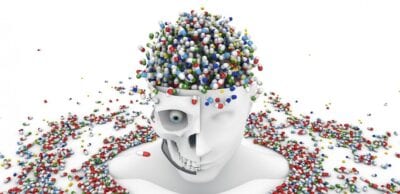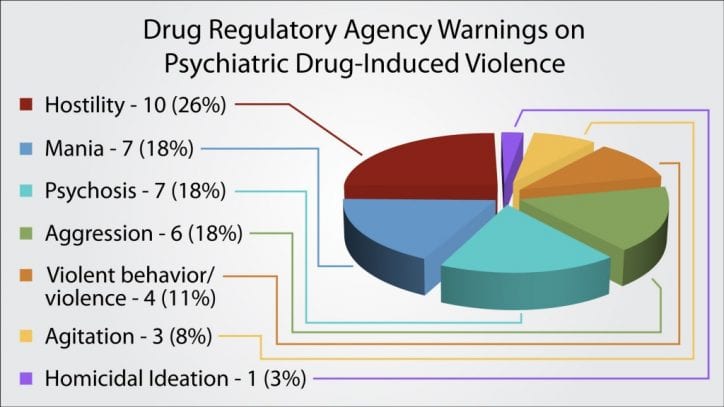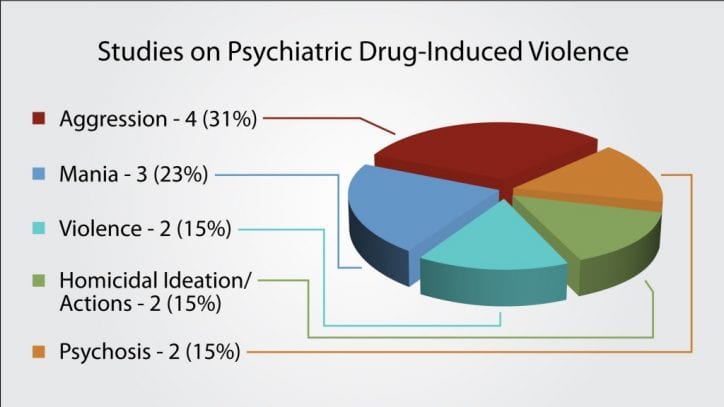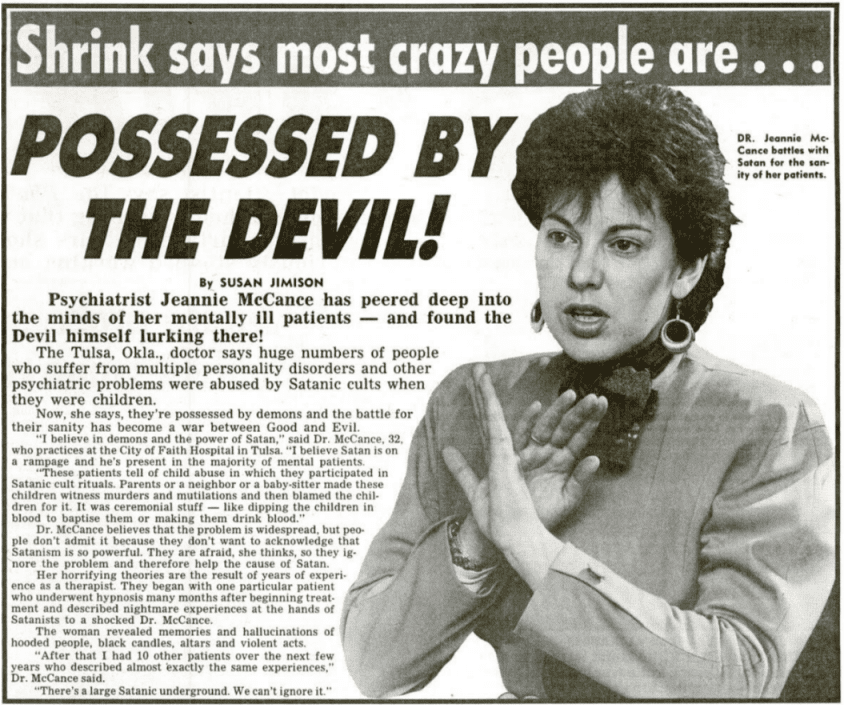Although the myth of “off his meds” lacks any scientific basis, there is a mountain of evidence that many psychiatric drugs themselves can cause violence, including the antidepressants. Many studies are readily available on my Antidepressant Resource Center, Section 5, “Antidepressant Violence, Aggression, Hostility, Irritability and Antisocial Behavior.” In addition, Dr. Peter Breggin’s book Medication Madness: the Role of Psychiatric Drugs in Cases of Violence, Suicide and Crime, summarizes the evidence and presents many true stories about drug-induced violence from his clinical and forensic experience as a psychiatrist. Psychiatric drugs are connected to a majority of mass shootings, a fact that is ignored by the mainstream media that receives billions of dollars in advertising from their manufacturers.
Psychiatric Drugs and Violence
The fake news media and its consultants from the Pharmaceutical Empire continue to argue that psychiatric drugs do not cause violence. On the 10th anniversary of the Columbine tragedy, USA Today caught the nation up on the “truth” about the motives of the perpetrators Eric Harris and Dylan Klebold. The newspaper stated unequivocally, “Contrary to early reports, Harris and Klebold weren’t on antidepressant medication.”
Actually, USA Today was not telling the truth. The fact is that Harris was taking the antidepressant Luvox (fluvoxamine) right up until the shooting. Luvox is very similar to Prozac, Paxil, Celexa and others called serotonin specific reuptake inhibitors (SSRIs).
As a medical expert in cases related to Eric Harris, Dr. Peter Breggin had access to his medical records. The records show that his doctor prescribed him progressively larger doses of Luvox for one year prior to the day he committed mass murder. During that year on Luvox, he developed his first known violent and psychotic feelings. Furthermore, the toxicology report based on blood samples from his autopsy showed that he had a “therapeutic” level of the drug in his blood. This demonstrated that he had taken the psychiatric drug shortly before his death and had an active amount in his system at the time of the shootings.
Dr. Breggin wrote to USA Today to correct the facts, and cited the toxicology report and a drug company report to the FDA confirming it. The newspaper never answered me or printed a retraction.
The fact is psychiatric drugs are documented by 27 international drug regulatory agency warnings and 16 published medical studies to cause side effects including mania, hostility, violence and even homicidal ideation. And while not everyone taking the drug will experience these particular side effects, what the warnings prove is that a percentage of the population will.
The correlation between psychiatric drugs and acts of violence and homicide is well documented—both by international drug regulatory warnings and studies, as well as by many cases where high profile acts of violence/mass murder were committed by individuals under the influence of psychiatric drugs. There have been 22 drug regulatory agency warnings from five countries and the European Union, on psychiatric drug-induced violence. These include the following (note that some warnings cite more than one side effect, so the list below may not be equal to the total number of warnings):
There have been 10 studies in four countries on psychiatric drug-induced violence. These include the following (note that some studies cite more than one side effect, so the list below may not be equal to the total number of studies):
Furthermore according to the FDA’s MedWatch reporting system for drug side effects, over a 10-year period, the FDA received 1,531 cases of homicidal ideation/homicide attributed to psychiatric drugs, 40% of which were reported by medical professionals. The FDA admits that only 1-10% of drug side effects are ever reported to MedWatch, so taking a medium range of 5%, the number could easily be 30,620 cases of homicidal ideation/homicide attributed to psychiatric drugs.
Regarding the concept that psychiatric drugs could not have been a contributing factor in a case where the perpetrator was involved in extensive planning or preparations, we look to the definition of “homicidal,” which includes homicidal ideation, a similar concept to the “suicidal ideation” black box warning on antidepressant drugs:
“Homicidal … may encompass a broad variety of ideation and behaviors. They may range from globally aggressive thoughts… to a specific lethal plan with available means to carry it out.”
— Emergency Psychiatry journal
There have been 65 high profile acts of senseless violence, including mass school shootings, mass stabbings, and even the intentional crashing of a commercial airplane, committed by individuals taking or withdrawing from psychiatric drugs, resulting in 357 dead and 336 wounded. Drug proponents argue that there are thousands of shootings and acts of violence that have not been correlated to psychiatric drugs, and that is exactly the point. They have neither been confirmed nor refuted to have been connected to psychiatric drugs, as law enforcement is not required to investigate or report on prescribed drugs linked to violence, and media rarely pose the question.
The New York State Senate recognized the lack of reporting correlating mind-altering psychiatric drugs to both suicide and violence as far back as 2000, when the senate introduced a bill which would “require police to report to the Division of Criminal Justice Services (DCJS), certain crimes and suicides committed by persons using psychotropic drugs,” citing “a large body of scientific research establishing a connection between violence and suicide and the use of psychotropic drugs.”
Unfortunately that bill stalled out in the finance committee, yet if that bill had passed, a reporting system would be in place to determine the extent to which violence is committed by those under the influence of mind-altering prescribed drugs.
A cursory review of the 27 international drug regulatory warnings, the tens of thousands of cases of medical personnel citing psychiatric drug side effects of homicide, aggression, violence, mania and psychosis, and the 65 high profile acts of senseless violence committed by individuals either taking or withdrawing from these drugs, more than meets the criteria for a federal investigation.
With millions of Americans being prescribed psychiatric drugs, it’s apparent not everyone will experience violent reactions to the drugs, besides which, violence is only one of many documented side effects of psychiatric drugs. But what the drug regulatory agency warnings confirm, is that a percentage of the population will. And no one knows who will be next.
While there is never one simple explanation for what drives a human being to commit such unspeakable acts of senseless violence, one common denominator has surfaced in a percentage of cases—prescribed psychiatric drugs which are documented to cause mania, psychosis, violence, suicide and in some cases, homicidal ideation. Those with a vested interest will continue to champion the use of such drugs, as the psychiatric-pharmaceutical drug industry rakes in $80 billion a year through psychiatric drug sales alone.
It is long past time that government healthcare agencies launch an investigation. Moreover the New York bill which would have required law enforcement to report any use of mind-altering psychiatric drugs prescribed to those who committed violent criminal acts should be reintroduced.
None can argue against the fact that disclosure would serve the public interest. Except those with a vested interest in keeping the public in the dark.
Some examples of high-profile cases where the individual was under the influence of such drugs include:
- Burlington, Washington – September 23, 2016: 20-year-old Arcan Cetin opened fire in a Macy’s department store at the Cascade Mall, killing 5 people. He was on three different psychiatric drugs—an antidepressant and ADHD drugs—as of 2015 and had been receiving drugs “like Prozac” in the months before the shooting. Side effects include homicidal ideation, agitation/hostility, mood changes and depression.
- Southern France – March 24, 2015: Pilot Andreas Lubitz deliberately crashed a Germanwings plane into the side of a mountain killing all 150 people on board. He was on an antidepressant and an anti-anxiety drug. Side effects of these drugs include homicidal ideation, hostility, aggression, mania and depression.
- Santa Barbara, California – May 23, 2014: 22-year-old Elliot Rodger stabbed three roommates to death at his apartment then drove to a sorority house where he shot three women, killing two of them. Driving again, he exchanged fire with deputies, hit a bicyclist, fired on other people in multiple locations and then killed himself having killed 6 and wounded 13 others. He was taking an anti-anxiety drug. Side effects include homicidal ideation, hallucinations, unusual changes in mood or behavior and depression.
- Fort Hood, TX – April 2, 2014: Specialist Ivan Lopez opened fire at Fort Hood military base, killing three people, wounding 16 others and then taking his own life. He had been prescribed an anti-anxiety drug, antidepressants and other medications to treat anxiety and depression. Side effects include homicidal ideation, abnormal thinking, hallucinations, behavioral changes and suicidal thoughts/actions.
- Washington, DC – September 16, 2013: Aaron Alexis opened fire at the Washington Navy Yard, killing 12 and wounding eight before he was killed by police. Alexis was prescribed an antidepressant. Side effects include homicidal ideation, aggressiveness, irritability, mania and akathisia.
- Aurora, CO – July 20, 2012: James Holmes opened fire at a movie theater during “The Dark Knight Rises,” killing 12 people and wounding 70. He was on an antidepressant and an anti-anxiety drug. Side effects include homicidal ideation, hallucinations, agitation, anxiety and behavior problems.
- Seal Beach, California – October 12, 2011: Scott DeKraai, a harbor tugboat worker, entered the hair salon where his ex-wife worked, shot and killed her and seven others and injuring one. He was prescribed an antidepressant and a “mood stabilizer.” Side effects include homicidal ideation, aggressiveness, irritability, mania and paranoia.
- DeKalb, Illinois – February 14, 2008: 27-year-old Steven Kazmierczak shot and killed five people and wounded 21 others before killing himself in a Northern Illinois University auditorium. His girlfriend said he had recently been taking an antidepressant and anti-anxiety drugs, but had stopped taking the antidepressant three weeks before the shooting. Toxicology results showed that he still had one of the anti-anxiety drugs in his system. Side effects include homicidal ideation, suicidal ideation, hallucinations and unusual changes in mood or behavior.
- Omaha, Nebraska – December 5, 2007: 19-year-old Robert Hawkins shot and killed eight people and wounded five before committing suicide in an Omaha mall. Autopsy results confirmed he was under the influence of an anti-anxiety drug. Side effects include homicidal ideation, confusion, depression, mania and agitation.
- Red Lake, Minnesota – March 21, 2005: 16-year-old Jeff Weise shot and killed his grandfather and his grandfather’s girlfriend, then went to his school on the Red Lake Indian Reservation where he shot dead 5 students, a security guard, and a teacher, and wounded 7 before killing himself. He was on an antidepressant. Side effects include homicidal ideation, suicidal ideation, hostility and psychosis.
- Columbine, Colorado – April 20, 1999: 18-year-old Eric Harris and his accomplice, Dylan Klebold, shot and killed 12 students and a teacher and wounded 26 others before killing themselves. Harris was on an antidepressant. Side effects include homicidal ideation, agitation, depression, suicidal thoughts or behaviors and mania. Klebold’s medical records remain sealed.
- Springfield, Oregon – May 21, 1998: 15-year-old Kip Kinkel murdered his parents and then proceeded to school where he opened fire on students in the cafeteria, killing two and wounding 25. Kinkel had been taking an antidepressant. Side effects include homicidal ideation, suicidal ideation, hostility and psychosis.
A longer, but not complete list can be found here…
(…and more in the History of Psychiatric Drugs at the end of the article)
Of course, also relating to correlation, there’s a chicken-or-egg question here: Is it that taking psychiatric drugs makes a person more likely to go crazy and commit murderous rampages, or is it that crazy people who are candidates for committing murderous rampages are more likely to be prescribed psychiatric drugs? In reality, most likely it’s both.
The truth is that because the human mind is complex and not wholly understood, taking mind-altering drugs is a risky proposition. Drug companies acknowledge this, too, mind you — just not very publicly. As Kupelian writes after relating the case of Andrea Yates, who drowned her five children in 2001 while on the antidepressant Effexor:
In November 2005, more than four years after Yates drowned her children, Effexor manufacturer Wyeth Pharmaceuticals quietly added “homicidal ideation” to the drug’s list of “rare adverse events.” The Medical Accountability Network, a private nonprofit focused on medical ethics issues, publicly criticized Wyeth, saying Effexor’s “homicidal ideation” risk wasn’t well publicized and that Wyeth failed to send letters to doctors or issue warning labels announcing the change. And what exactly does “rare” mean in the phrase “rare adverse events”? The FDA defines it as occurring in less than one in 1,000 people. But since that same year 19.2 million prescriptions for Effexor were filled in the U.S., statistically that means thousands of Americans might experience “homicidal ideation” — murderous thoughts — as a result of taking just this one brand of antidepressant drug. Effexor is Wyeth’s best-selling drug, by the way, which in one recent year brought in over $3 billion in sales, accounting for almost a fifth of the company’s annual revenues.
Then, after mentioning the case of 12-year-old Paxil user Christopher Pittman’s murder of his grandparents, Kupelian informs that “Paxil’s known ‘adverse drug reactions’ — according to the drug’s FDA-approved label — include ‘mania,’ ‘insomnia,’ ‘anxiety,’ ‘agitation,’ ‘confusion,’ ‘amnesia,’ ‘depression,’ ‘paranoid reaction,’ ‘psychosis,’ ‘hostility,’ ‘delirium,’ ‘hallucinations,’ ‘abnormal thinking,’ ‘depersonalization’ and ‘lack of emotion,’ among others.”
In fact, as Ch 2 WCGH reported in 2009, “One study shows a quarter of all children on drugs such as Paxil and Zoloft become dangerously violent and/or suicidal.” Below is a 2011 news report on the subject by WCNC.COM 6 News; it includes the story of Christopher Pittman.
Of course, if these drugs pose such a threat, there should be a stream of high-profile lawsuits, right? Wrong. To avoid the bad exposure this would bring, drug companies spend hundreds of millions of dollars settling claims out of court and often cloak them with confidentiality agreements.
Having said this, it’s unlikely that psychiatric drugs are entirely to blame for mass shootings, for much has changed during the last many decades. We’ve seen a decline in faith and rise in moral relativism/nihilism, which relates the notion that right and wrong are mere “perspective”; entertainment has become increasingly decadent and mindlessly violent (note that the Internet’s rise fairly closely coincided with the start of continual mass shootings); the family has continued to break down, and Americans today, immersed in electronics, are often more connected to things than people; and the fame committing a massacre brings can be alluring to lonely, disturbed people, thus breeding copycat crimes, to name just a few factors. It’s a systemic problem.
Nonetheless, adding mind-altering drugs to this equation adds up to nothing good, and this brings me to my story. I knew a good-natured man who was the epitome of even-temperedness, who had some problems and was prescribed an antidepressant by a psychiatrist (who’d never treated him before). Well, he swallowed one pill — and only one, ever. In his case, that was all it took. Fifteen minutes later, he flew into a rage and was never the same again. Mental instability, irrationality, and some violent episodes — in a word, insanity — would define the rest of his life.
Famed psychiatrist Sigmund Freud once believed that cocaine, legal during his younger days, was the best cure for depression there’d ever been. “Bayer Heroin” was once advertised as a remedy for all sorts of ailments. Today, with one out of six Americans on some psychiatric medication, we ought to perhaps bear in mind that just because a drug is on the right side of the law doesn’t mean it won’t bring you to the wrong side of sanity’s line.
“Modern medicines, with specific emphasis on pharmaceutical drugs and vaccines, are responsible for more suffering and death over the last century of their massive proliferation, than any war in human history!”
This is not a guess or an exaggeration, it is a statistical fact. In addition, “Witchcraft” or “sorcery” in the bible translates from the Greek ‘pharmakeia‘ meaning “drug-related sorcery, like the practice of magical-arts, etc.” (A. T. Robertson). Also, a pharmakós (Greek: φαρμακός, plural pharmakoi) in Ancient Greek religion was the ritualistic sacrifice or exile of a human scapegoat or victim. Interestingly, some of the mass shooters listed above are merely patsies (or scapegoats) of false flag mass shootings organized by the dark side of the FBI and CIA sometimes as ritualistic sacrifices to their Luciferian god, or sacrifices for ‘a greater good’ as they see it, in order to bring about a new world order global dictatorship.
Psychiatric Drugs and Withdrawal Reactions
When patients do become much more overtly disturbed when stopping their drugs, it is typically the result of a withdrawal reaction. One of my most successful malpractice suits in which Dr. Breggin consulted and testified resulted in an $11.9 million verdict for the family of the deceased.
The case was based upon the death of a prisoner whose antidepressant Paxil (paroxetine) had been stopped on admission to jail, resulting in a withdrawal reaction over several days that made him too disturbed to communicate. The jail doctor, without asking how long the inmate had been off his Paxil, restarted him on 30 mg.
The patient had been taking that dose for several years; but his body was no longer accustomed to it. If the doctor wished his patient to resume Paxil, he should have gradually raised his dose to re-accustom his body and brain to it.
After the first dose, the patient killed himself, probably from a combination of withdrawal and acute toxicity. His method of suicide was extremely painful and violent toward himself, which commonly occurs in antidepressant-induced suicides (see my Antidepressant Resource Center Section 2C for research papers).
How to Reduce Violence
If we want to reduce violence the answer is not more psychiatric drugging, but less. Forcing patients to take drugs results in their stopping them secretly without proper clinical supervision and the support of a social network.
Imagine running an industry where you can force people to use your products—even if the products are poisonous neurotoxins. Imagine convincing people that they are indispensable to a smooth-running society. Imagining getting the government to enforce your profit-making goals of turning people into consumers whether they want your products or not?
Well, all that has now happened. It is time to stop it. A population with far fewer drugged citizens will be a far safer and healthier society.
In the absence of any objective medical tests to determine who has ADD or ADHD, doctors rely in part on standardized assessments and the impressions of teachers and guardians while the they administer leave little room for other causes or aggravating factors, such as diet, or environment. Hence, diagnosing a child or adolescent with ADD or ADHD is often the outcome, although no organic basis for either disease has yet to be clinically proven.
Psychiatrists may then prescribe psychotropic drugs for the children without first making it clear to parents that these medications can have severe side-effects including insomnia, loss of appetite, headaches, psychotic symptoms and even potentially fatal adverse reactions, such as cardiac arrhythmia. And yet, despite these dangers, many school systems actually work with government agencies to force parents to drug their children, threatening those who refuse with the prospect of having their children taken from the home unless they cooperate.
The playlist below has some excellent videos:
Sources:
- https://www.cchrint.org/2017/10/10/another-mass-shooting-another-psychiatric-drug/
- DrBreggin’s website
- https://www.thenewamerican.com/usnews/crime/item/28307-from-prozac-to-parkland-are-psychiatric-drugs-causing-mass-shootings
- https://www.cchrint.org/psychiatricdrugs-violence/
Chronological History of Events Related to Psychiatric Drugs

DEA Seizes A Record-Breaking $20 Million In Fentanyl In Southern California

Leftist Car-ram Attacks US Capitol, Kills an Officer, then Killed by Capitol Police

Study: High Fructose Intake May Drive Aggressive Behaviors, ADHD, More

Paris Hilton Releases New Documentary “This is Paris”, Reveals That She Was Subjected to MKULTRA-Style Abuse
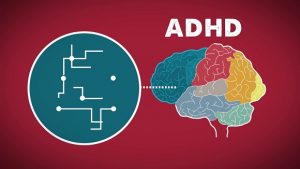
Vitamin D Deficiency During Pregnancy Connected to Elevated Risk of ADHD

Report: New drug-pricing data shows stunning hikes—one whopping 667% increase

Antidepressants for Seniors Have Doubled in Two Decades

Study: Safety of Safety Evaluation of Pesticides (Dow Chemical Faked Safety Studies on Brain-Damaging Chlorpyrifos)

Study: ADHD Linked to Parkinson’s Disease


